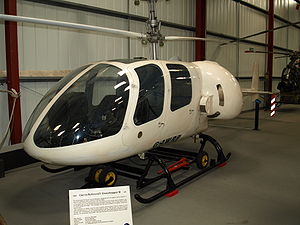- Cierva CR Twin
-
CR Twin Cierva Grasshopper III on display at the Helicopter Museum (Weston). Role Utility helicopter Manufacturer Cierva Autogiro Company / Rotorcraft Ltd Designer J S Shapiro First flight 18 August 1969 Number built 3 The Cierva CR Twin (originally designated CR LTH.1 and also known as the Grasshopper III) was a five-seat utility helicopter that first flew in the UK in 1969. It was a joint development between Cierva Autogiro Company and Rotorcraft now a subsidiary of Cierva, based on the dynamic systems of the latter company's Grasshopper design. A new, highly-streamlined pod-and-boom fuselage was married to the Grasshopper's coaxial rotor system, and the new aircraft registered G-AWRP first flew on 18 August 1969.
Two further prototypes followed, G-AXFM later in 1969 and G-AZAU in 1971, this latter example fitted with 210 hp Continental IO-360-D engines in place of the Rolls-Royce Continental O-300 units of the first two machines. Financial backing could not be obtained for further development, and the project was abandoned by 1975. The first prototype is preserved at The Helicopter Museum in Weston-super-Mare.
Contents
Variants
- CR Twin - prototypes (3 built)
- CR.420 - proposed production variant with 210 hp Continental TSIO-360-A engines (not built)
- CR.640 - proposed production variant with 320 hp Continental Tiara T6-320 engines (not built)
Specifications
Data from Jane's All The World's Aircraft 1971-72 [1]
General characteristics
- Crew: One pilot
- Capacity: 4 passengers
- Length: 28 ft 2 in (8.58 m)
- Main rotor diameter: 2× 33 ft 0 in (10.06 m)
- Height: 9 ft 11 in (3.02 m)
- Main rotor area: 804 ft2 (74.7 m2)
- Empty weight: 1,935 lb (878 kg)
- Gross weight: 3.150 lb (1,439 kg)
- Powerplant: 2 × Continental IO-360, 135 hp (101 kW) each
Performance
- Maximum speed: 130 mph (209 km/h)
- Cruise speed: 120 mph (193 km/h)
- Range: 500 miles (804 km)
- Service ceiling: 20,000+ ft (6,100+ m)
- Rate of climb: 1,400 ft/min (7.1 m/s)
See also
References
- Notes
- ^ Taylor 1971, pp.186-187.
- Bibliography
- Taylor, John W.R. (ed.) (1971). Jane's All The World's Aircraft 1971-72. London: Jane's Yearbooks. ISBN 354 00094 2.
- Taylor, Michael J. H. (1989). Jane's Encyclopedia of Aviation. London: Studio Editions. pp. 255.
- Simpson, R. W. (1998). Airlife's Helicopters and Rotorcraft. Ramsbury: Airlife Publishing. pp. 212.
External links
Aircraft produced by Cierva/Cierva Autogiro Company/Weir Lists relating to aviation General Aircraft (manufacturers) · Aircraft engines (manufacturers) · Airlines (defunct) · Airports · Civil authorities · Museums · Registration prefixes · Rotorcraft (manufacturers) · TimelineMilitary Accidents/incidents Records Categories:- British civil utility aircraft 1960–1969
- British helicopters 1960–1969
- Cancelled aircraft projects
- Cierva aircraft
- Coaxial rotor helicopters
Wikimedia Foundation. 2010.

